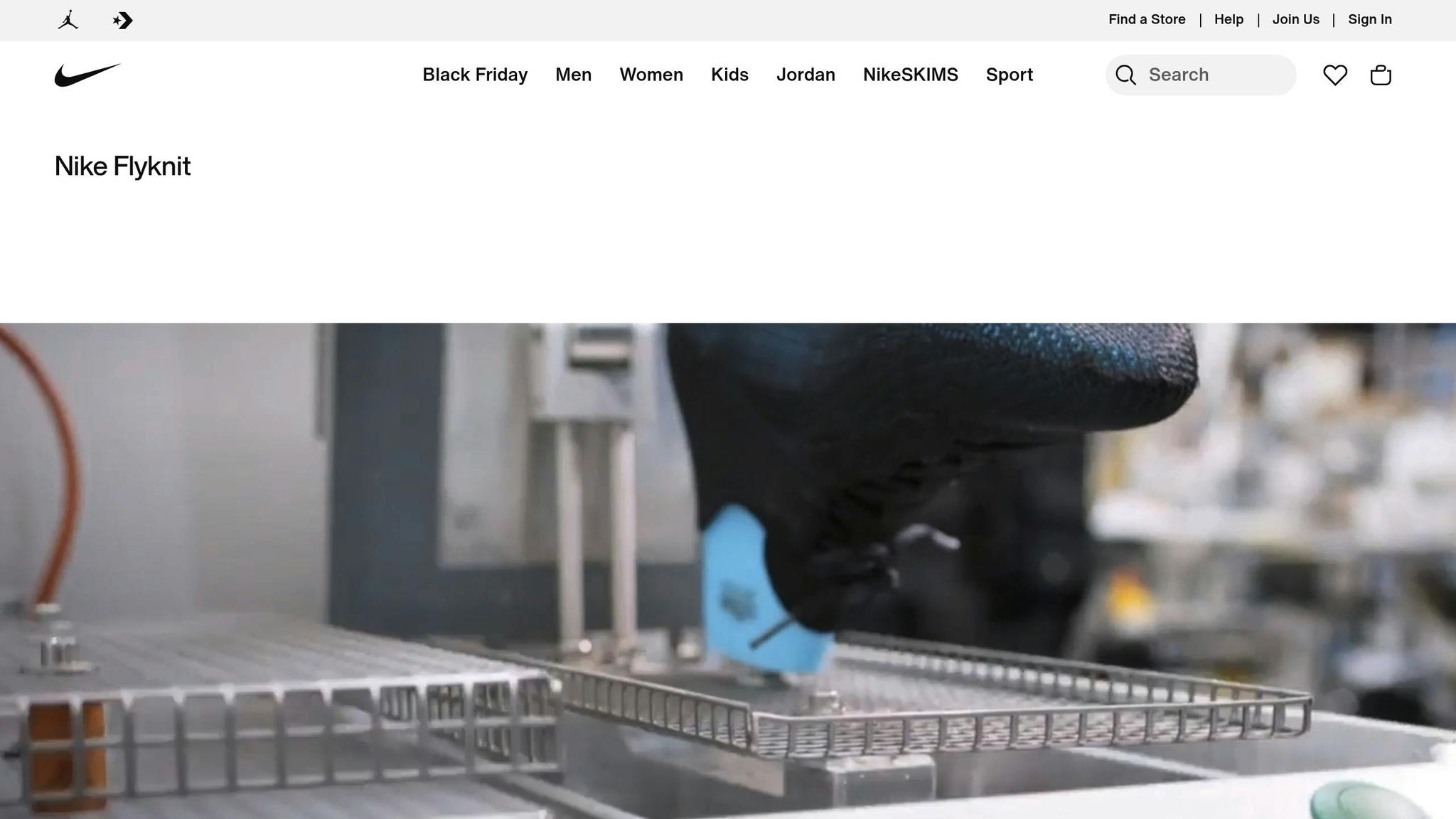Flyknit handbags are transforming how we think about eco-conscious fashion. By using precision knitting technology, these bags minimize waste, incorporate recycled materials, and reduce energy use during production. Unlike traditional methods, Flyknit creates handbags in a single piece, cutting down on fabric scraps and unnecessary steps. Plus, the process uses materials like recycled polyester, repurposing plastic bottles into durable, lightweight, and stylish accessories.
Key Benefits:
- Waste Reduction: Flyknit uses exactly the amount of yarn needed, reducing material waste by up to 60%.
- Recycled Materials: Each bag repurposes 6–7 plastic bottles, helping to divert nearly 1 billion bottles annually from landfills.
- Energy Efficiency: Fewer production steps mean lower energy consumption compared to conventional methods.
- Dauerhaftigkeit: The one-piece design resists wear and tear, making these bags long-lasting.
Flyknit handbags combine style, durability, and practicality while addressing the environmental challenges of the fashion industry. Choosing one supports smarter production practices and reduces your carbon footprint.
Why Is Flyknit So Sustainable For Sneakers? – Sneaker Culture Digest

Understanding Flyknit Technology
Flyknit technology marks a major shift in how textiles are manufactured. Unlike the traditional cut-and-sew approach, which often generates significant waste, Flyknit relies on automated knitting machines to produce items in a single, continuous piece. This precision-driven method places yarn exactly where it’s needed, significantly cutting down on material waste.
The idea behind Flyknit emerged from a desire to create high-performance products while reducing their environmental footprint. By knitting items directly into their final shape, the process uses just the right amount of yarn required for the finished product – nothing more, nothing less.
What sets Flyknit apart is its ability to adjust tension, structure, and material composition within a single piece. Thanks to computerized knitting, the process can create areas with different thicknesses, flexibility, or strength – all without seams or separate components. Achieving this level of precision is nearly impossible with older manufacturing techniques.
The Flyknit Production Process
The process starts with digital design files that map out every yarn placement in 3D space. Engineers program these files with exact specifications, deciding where reinforcement is needed, where flexibility is key, and how various sections should work together.
These instructions are then fed into specialized knitting machines. Using multiple yarn feeds, the machines weave fibers into intricate patterns, often incorporating materials like recycled polyester or organic cotton for a more sustainable touch.
This single-piece construction eliminates the need to cut fabric sheets into smaller pieces, which is where much of the waste in traditional methods occurs. For example, instead of separately producing a bag’s body, lining, straps, and pockets for later assembly, Flyknit integrates all these elements into one seamless piece. This approach reduces not only waste but also the need for additional processing steps.
Leftover yarn? It doesn’t go to waste – it’s recycled back into production, creating a more sustainable manufacturing loop.
Applying Flyknit to Handbags
Using Flyknit for handbags required a complete rethinking of their design and assembly. Handbags have specific requirements: they need to support varying weights, hold their shape whether full or empty, provide secure closures, and include practical features like pockets and compartments.
Designers developed advanced knitting patterns to meet these demands without losing the eco-friendly benefits of Flyknit. For example, reinforced bases improve weight distribution, built-in structural elements help bags maintain their shape, and integrated organizational features reduce the need for additional sewn components.
To handle stress points – like handles, bases, and frequently touched edges – Flyknit handbags include reinforcement zones. These are created by increasing yarn density or blending in sturdier fibers in key areas, all while maintaining the seamless, single-piece design.
Flyknit also allows for functional upgrades that are hard to achieve with traditional methods. Interior pockets can be knitted directly into the bag’s structure, adjustable straps can feature built-in tension zones for added comfort, and closures can be engineered right into the fabric, reducing the need for extra hardware.
From a design perspective, Flyknit offers incredible flexibility. It can produce intricate patterns, smooth color gradients, and varied textures in one go. This means a handbag can have a textured exterior, a smooth interior lining, and decorative accents – all created in a single manufacturing step.
The streamlined production process has practical advantages, too. By reducing the need for traditional assembly, Flyknit handbags can be made more efficiently. This not only cuts down on production time and energy use but also helps make sustainable accessories more accessible to a wider audience. These design breakthroughs naturally lead to everyday benefits, which we’ll dive into next.
How Flyknit Handbags Support Environmental Goals
Flyknit technology offers a forward-thinking approach to reducing fashion’s environmental impact. By reimagining how handbags are made, this method tackles ecological challenges head-on, creating a more sustainable path for handbag production. The benefits of this approach are particularly evident in how materials are used, energy is conserved, and waste is minimized.
Reducing Material Waste
Traditional handbag production often wastes large amounts of fabric. This happens when big sheets of material are cut into smaller pieces, leaving behind scraps that are rarely reused. Flyknit technology changes the game by knitting handbags directly into their final shape. This precision-based process drastically cuts down on waste, and any leftover yarn can be recycled back into the system. It’s a smarter, more efficient way to manufacture that supports a closed-loop production model.
Incorporating Recycled and Renewable Materials
Flyknit technology is compatible with a variety of sustainable materials, making it easier for manufacturers to use eco-friendly options. For example, recycled polyester, often sourced from post-consumer plastic bottles, fits seamlessly into the process. The technology also supports natural fibers like organic cotton and bamboo-derived yarns. By prioritizing these materials, Flyknit reduces dependence on resource-heavy raw materials and helps shrink the carbon footprint of production. This approach not only conserves resources but also cuts down on energy use during material processing.
Cutting Energy Use in Manufacturing
Traditional handbag manufacturing typically involves several energy-intensive steps, such as cutting, sewing, and assembling different components. Flyknit simplifies this by combining these steps into a single, streamlined process. This not only reduces energy consumption but also limits waste from errors or rework. As the technology continues to evolve and scale, its energy-saving potential grows, making it an increasingly sustainable choice for handbag production.
sbb-itb-1e6451b
Everyday Benefits of Flyknit Handbags
Flyknit handbags aren’t just about their eco-friendly appeal – they’re built for everyday practicality too. Thanks to their seamless, one-piece weave made from high-quality materials, these bags are incredibly durable. Unlike traditional designs with stitched or glued sections that can wear out over time, Flyknit’s continuous construction resists daily wear and tear. This means you get a reliable, long-lasting accessory that combines performance with sustainability – a win-win for modern lifestyles.
Why Choose Flyknit Handbags Over Other Options
Building on the eco-friendly aspects mentioned earlier, Flyknit technology stands out not just for its sustainability but also for its impressive performance compared to traditional handbag materials. This innovative approach combines reduced environmental impact with practical, long-lasting design. Its efficient production process minimizes waste while enhancing usability.
Flyknit vs. Standard Handbag Materials
Conventional materials come with their own set of challenges. Leather, for instance, involves water-intensive tanning processes and heavy chemical usage. Synthetic materials, often derived from petroleum, contribute to pollution during production. Even canvas, though sturdy, doesn’t always meet modern performance expectations.
Flyknit, on the other hand, is crafted through a precise knitting process that minimizes waste and strengthens the overall structure. This results in a lightweight, breathable fabric that allows for better air circulation, helping to reduce moisture and odors. Plus, its water-resistant coatings maintain the material’s flexibility while staying aligned with eco-conscious goals.
Supporting Environmental Goals
Flyknit handbags take sustainability a step further by incorporating recycled fibers and requiring fewer resources during manufacturing. These bags are built to last, which means fewer replacements and less waste over time. This directly supports broader environmental objectives like cutting down material consumption and extending product lifespans.
Choosing Flyknit also encourages innovation in sustainable fashion. As more shoppers opt for eco-friendly alternatives, brands are motivated to improve their green practices. While no production method is entirely without impact, selecting a Flyknit handbag is a meaningful way to reduce your personal environmental footprint.
For those who value both style and sustainability, Flyknit handbags offer a smart choice. They deliver durability and functionality without sacrificing eco-conscious principles, making them a standout option in the world of sustainable fashion.
Conclusion: Choosing Flyknit Handbags for a Better Future
Sustainable fashion bridges the gap between style and responsibility, and Flyknit handbags are a perfect example of this balance. These bags show how eco-conscious choices can align with the demands of everyday life. The technology behind Flyknit addresses some of fashion’s biggest environmental issues while delivering products designed for practicality and durability.
Flyknit technology significantly reduces material waste – by up to 60% compared to traditional manufacturing methods. Each bag incorporates recycled materials, using the equivalent of 6–7 plastic bottles per product. This process helps divert nearly 1 billion plastic bottles from landfills and waterways every year.
The benefits go beyond waste reduction. Using recycled polyester decreases carbon emissions by up to 30% compared to virgin polyester, while recycled nylon cuts emissions by as much as 50% compared to its virgin counterpart. These reductions represent a meaningful step toward lowering the fashion industry’s environmental footprint.
Flyknit handbags don’t just focus on sustainability – they’re built for performance too. They’re lightweight yet strong, breathable, and comfortable, making them ideal for everything from commutes to travel. The seamless construction enhances durability, reducing the need for frequent replacements and further supporting waste reduction efforts.
Every Flyknit handbag purchase contributes to more than just your wardrobe; it’s a step toward a cleaner, more resource-efficient future. By choosing these bags, you’re supporting practices that prioritize waste reduction, resource conservation, and long-lasting design. This approach minimizes landfill contributions and encourages the continued development of sustainable materials and production techniques.
Flyknit technology represents an essential shift in how fashion can be both functional and eco-friendly. By opting for Flyknit handbags, you’re playing a part in promoting responsible consumption and paving the way for a healthier planet. Make the choice to support sustainable fashion and take a step toward a brighter future.
FAQs
How does Flyknit technology help make handbag production more eco-friendly?
Flyknit technology takes a big step forward in reducing material waste during production. By utilizing precise knitting techniques, it minimizes excess fabric, cutting waste by up to 60% compared to traditional manufacturing methods. This makes it a smarter choice for reducing production waste.
What’s more, Flyknit materials often incorporate recycled or eco-friendly fibers, shrinking their environmental impact even further. This approach doesn’t just prioritize sustainability – it also produces handbags that are lightweight, durable, and versatile, catering perfectly to consumers who care about the planet.
Why are Flyknit handbags more durable than those made with traditional methods?
Flyknit handbags stand out for their durability, thanks to advanced knitting technology that creates a single, seamless piece of fabric. By eliminating seams and stitches – common weak spots in traditional bags – these handbags are less prone to wear and tear over time.
What’s more, the materials used in Flyknit technology are both lightweight and incredibly strong. This means the bags can endure daily use while maintaining their shape and structure. The thoughtful design and sturdy materials make Flyknit handbags an excellent option for those seeking long-lasting, eco-conscious fashion.
Can Flyknit technology be used for other types of fashion items, and what are the benefits?
Flyknit technology isn’t limited to handbags – it can also be used in various fashion items like athletic shoes, including basketball and soccer footwear. This method brings some standout advantages, such as cutting down on material waste, creating lightweight designsund improving breathability.
Expanding the use of Flyknit across more products could help the fashion industry adopt greener practices while giving consumers durable and comfortable choices. Its adaptability positions it as a smart option for those seeking eco-friendly designs in today’s fashion landscape.




 Mobile/What's App/Wechat
Mobile/What's App/Wechat E-Mail
E-Mail ADD
ADD




